

Ragnarök. The north portal of the 11th century Urnes stave church has been interpreted as containing depictions of snakes and dragons that represent Ragnarök.
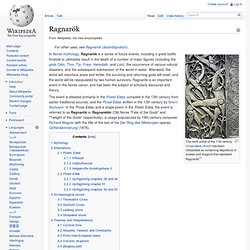
Valkyries, Wish-Maidens, and Swan-Maids. Dear Viking Answer Lady: I am a high school coach for girls' sports.
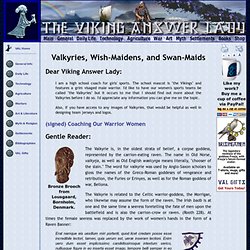
The school mascot is "the Vikings" and features a grim visaged male warrior. I'd like to have our women's sports teams be called "the Valkyries" but it occurs to me that I should find out more about the Valkyries before I do so. I'd appreciate any information you can give me on the topic. Also, if you have access to any images of Valkyries, that would be helpful as well in designing team jerseys and logos. (signed) Coaching Our Warrior Women Gentle Reader: Runic Divination. Thence come maidens who know much, Three from that hall beneath the tree: One was named Origin, the second Becoming.
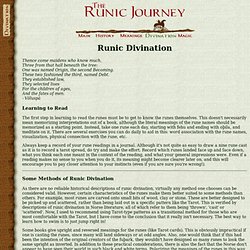
These two fashioned the third, named Debt. They established law, They selected lives For the children of ages, And the fates of men. - Völuspà Learning to Read The first step in learning to read the runes must be to get to know the runes themselves. This doesn't necessarily mean memorizing interpretations out of a book, although the literal meanings of the rune names should be memorized as a starting point. Always keep a record of your rune readings in a journal.
Some Methods of Runic Divination As there are no reliable historical descriptions of runic divination, virtually any method one chooses can be considered valid. Some books give upright and reversed meanings for the runes (like Tarot cards). The Trouble with Loki. “Wait a minute,” I said, leaning back in the nicest theater seat I’d ever sat in.
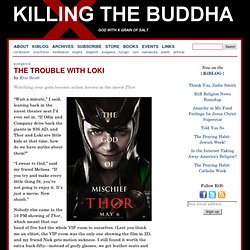
“If Odin and Company drive back the giants in 936 AD, and Thor and Loki are little kids at that time, how do we have myths about them?” “I swear to God,” said my friend Melissa. “If you try and make every little thing fit, you’re not going to enjoy it. It’s just a movie. Now shush.” Nobody else came to the 10 PM showing of Thor, which meant that our band of five had the whole VIP room to ourselves. That took the edge off the film, which I had been anxious about. But still, I am a pagan. But names and symbols have meaning and power, and, rightly or wrongly, these felt like my names and my symbols. Believe it or not, even when I wrote “Valhal-Mart,” I wanted to like Thor. The movie goes a little something like this. Norse Sagas. The word "saga", probably mean "What is told".

Norse sagas are similar to epic, but usually refer to works compiled during medieval Iceland. Saga is usually a narrative, either in poems or prose, dealing with historical, legendary and mythical subjects, written in Old Norse, during the 13th-14th century. The Icelandic sagas can be divided into three different categories: Kings' Sagas, Family Sagas, and Heroic or Legendary Sagas. I have chosen to only to deal with the Heroic Sagas, which is often called fornaldar saga or "saga of antiquity". Norse mythology. An undead völva, a Scandinavian seeress, tells the spear-wielding god Odin of what has been and what will be in Odin and the Völva by Lorenz Frølich (1895)

Norse Mythology. “Heimdall on the Rainbow Bridge” by Emil Doepler (1905) Heimdall (pronounced “HAME-doll;” Old Norse Heimdallr, whose meaning/etymology is unknown[1]) is one of the Aesir gods and the ever-vigilant guardian of the gods’ stronghold, Asgard.
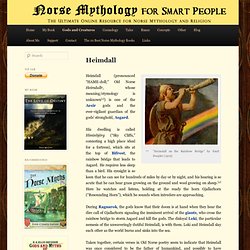
His dwelling is called Himinbjörg (“Sky Cliffs,” connoting a high place ideal for a fortress), which sits at the top of Bifrost, the rainbow bridge that leads to Asgard. He requires less sleep than a bird. His eyesight is so keen that he can see for hundreds of miles by day or by night, and his hearing is so acute that he can hear grass growing on the ground and wool growing on sheep.[2] Here he watches and listens, holding at the ready the horn Gjallarhorn (“Resounding Horn”), which he sounds when intruders are approaching. Norse Mythology. Odin (pronounced “OH-din”; Old Norse Óðinn, Old English and Old Saxon Woden, Old High German Wuotan, Wotan, or Wodan, Proto-Germanic *Woðanaz, “Master of Ecstasy”) is one of the most complex and enigmatic characters in Norse mythology, and perhaps in all of world literature.
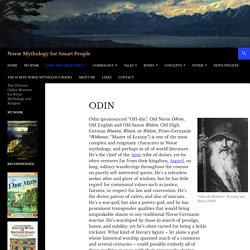
He’s the chief of the Aesir tribe of deities, yet he often ventures far from their kingdom, Asgard, on long, solitary wanderings throughout the cosmos on purely self-interested quests. He’s a relentless seeker after and giver of wisdom, but he has little regard for communal values such as justice, fairness, or respect for law and convention. He’s the divine patron of rulers, and also of outcasts.
He’s a war-god, but also a poetry-god, and he has prominent transgender qualities that would bring unspeakable shame to any traditional Norse/Germanic warrior. He’s worshiped by those in search of prestige, honor, and nobility, yet he’s often cursed for being a fickle trickster. What’s in a Name? War Sovereignty Poetry. Norse Mythology. The “Venus of Willendorf” (c. 23,000 BCE, found in modern-day Austria) Nerthus (Proto-Germanic *Nerþus) is a pre-Christian goddess venerated by some of the continental Germanic tribes described by the Roman historian Tacitus in his Germania (authored about 100 CE).
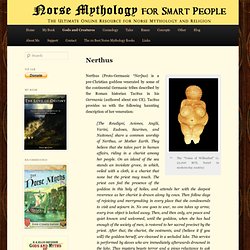
Tacitus provides us with the following haunting description of her veneration: Norse Mythology. Norse Mythology. “Tyr and Fenrir” by John Bauer (1911) Tyr (pronounced like the English word “tear”; Old Norse Týr, Old English Tiw, Old High German *Ziu, Gothic Tyz, Proto-Germanic *Tiwaz, “god”[1][2]) is a relatively minor Aesir god in Viking Age Norse mythology.
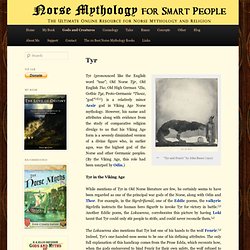
However, his name and attributes along with evidence from the study of comparative religion divulge to us that his Viking Age form is a severely diminished version of a divine figure who, in earlier ages, was the highest god of the Norse and other Germanic peoples. The Vanir Gods and Goddesses. Norse Mythology. “Njord’s Desire of the Sea” by W.G. Collingwood (1908) Njord (pronounced “NYORD;” Old Norse Njörðr, whose meaning/etymology is unknown) is one of the principal gods of the Vanir tribe of deities.
He’s also an honorary member of the Aesir gods, having been sent to them during the Aesir-Vanir War along with his son, Freyr, and his daughter, Freya. Freyr and Freya’s mother is Njord’s unnamed sister, who, based on linguistic evidence, is probably Nerthus. Njord was particularly associated with wealth, fertility, the sea, and seafaring in historical Germanic religion.[1][2] A saying among the Norse peoples held especially wealthy people to be “as rich as Njord.”[3] The tale in which Njord features most prominently is The Marriage of Njord and Skadi.
Unfortunately, that’s about all that the surviving sources tell us about Njord. The Aesir Gods and Goddesses. Norse Mythology. Freya (Old Norse Freyja, “Lady”) is one of the preeminent goddesses in Norse mythology. She’s a member of the Vanir tribe of deities, but became an honorary member of the Aesir gods after the Aesir-Vanir War. Her father is Njord. Her mother is unknown, but could be Nerthus. Freyr is her brother. Valhalla. Norse Mythology. “Thor’s Battle with the Giants” by Mårten Eskil Winge (1872) Thor (Old Norse Þórr, Old English Đunor, Old High German Donar, Proto-Germanic *Þunraz, “Thunder”[1]) is one of the most prominent figures in Norse mythology. He was a major god of all branches of the Germanic peoples before their conversion to Christianity, although he reached the height of his popularity among the Scandinavians of the late Viking Age. The Warrior God Par Excellence Thor, the brawny thunder god, is the archetype of a loyal and honorable warrior, the ideal toward which the average human warrior aspired.
He’s the indefatigable defender of the Aesir gods and their fortress, Asgard, from the encroachments of the giants, who are usually (although far from invariably) the enemies of the gods. No one is better suited for this task than Thor. Norse Mythology.